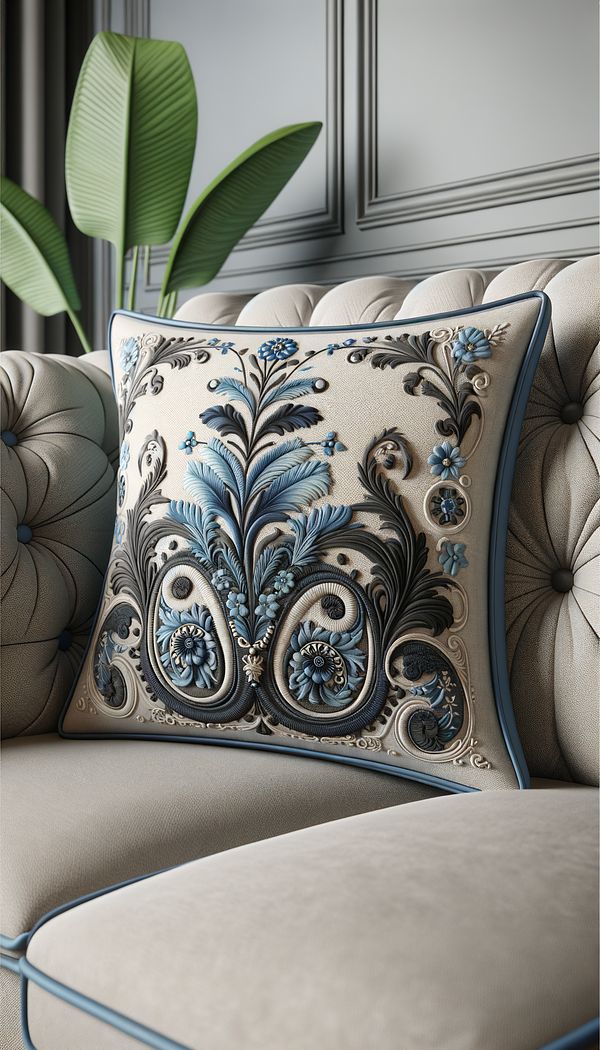What is Piping?
Piping is a decorative design element, consisting of a strip of folded fabric, used for trimming or outlining the seams of furniture or soft furnishings.
Description
Piping, also known as cording, is a thin strip of fabric that is covered around a cord. It is primarily used as a decorative element to outline the edges or seams of upholstery, cushions, and certain types of furniture. This design technique not only adds a subtle detail that can accentuate the shapes and lines of the item it embellishes, but it can also enhance the overall aesthetic of an interior space. Piping is commonly made from a variety of materials including cotton, polyester, silk, and leather, and is available in numerous colors and patterns to match or contrast with the main fabric of the furniture or furnishings.
Piping serves a dual purpose in interior design: it provides a clean, finished look to the edges of fabric products, and it reinforces the seams where it is applied, making them more durable and resistant to wear and tear. In addition to its functional benefits, piping can be a key element in defining the style of a piece, from classic and traditional to contemporary and modern, depending on the choice of fabric and placement.
The technique of applying piping involves sewing the fabric strip along the seam or edge of the upholstery or furnishing object, making sure that the cord inside the strip creates a smooth, rounded edge. This requires precision and skill, especially when working with intricate shapes or corners.
Usage
Piping is commonly found on a wide range of interior elements, including sofas, armchairs, decorative pillows, curtain edges, and even certain types of bedding. It can also be seen outlining the edges of window treatments like valances, giving them a more polished look. In more traditional settings, piping might feature heavily on period piece furniture, such as Victorian-style sofas, where it contributes to the historical accuracy and visual appeal of the design. Conversely, in modern interiors, piping might be used in a more understated way to highlight clean lines and minimalistic designs.
FAQs
-
Is piping only used for decorative purposes?
No, while piping is predominantly used as a decorative element, it also serves to reinforce seams, making them more durable.
-
Can I add piping to existing furniture?
Yes, piping can be added to existing furniture as part of a reupholstering project to update its appearance or to repair and reinforce worn edges.
-
Do I have to match the piping to my furniture fabric?
Not necessarily. While matching the piping to your furniture fabric can create a cohesive look, contrasting colors or patterns can add a bold accent to your piece.
Practical Application
When considering adding piping to your design project, think about the overall aesthetic you wish to achieve. For a subtle, sophisticated look, choose piping in a fabric that matches your piece. If you're aiming for a more dynamic, eye-catching style, opt for contrasting colors or patterns. Always consider the durability of the material, especially for high-use items like sofas and armchairs. Engaging a professional upholsterer is recommended to ensure a smooth, professional finish, particularly for complex pieces.
-
Furniture Types599 articles
-
Decorative Techniques322 articles
-
Decorating Principles & Elements330 articles
-
Materials & Textiles360 articles
-
Textiles & Upholstery252 articles
-
DecoDeco, short for Art Deco, is a visual arts design style that emerged in the 1920s and 1930s.
-
Kiln DriedKiln drying is a process of removing moisture from wood by using a kiln.
-
FiguringFiguring refers to the natural patterns and markings found in wood.
-
BobecheA decorative element that surrounds the base of a candle or candelabra to catch wax drippings.
-
Accent WallAn accent wall is a wall that is designed to stand out from the surrounding walls in a room.
